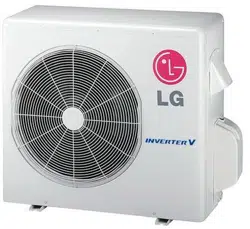Loading ...
Loading ...
Loading ...

Due to our policy of continuous product innovation, some specications may change without notication.
©
LG Electronics U.S.A., Inc., Englewood Cliffs, NJ. All rights reserved. “LG ” is a registered trademark of LG Corp.
REFRIGERANT DESIGN | 57
Refrigerant Piping Design & Layout Best Practices
Field-Provided Isolation Ball Valves
LG maintains a neutral position on using isolation valves in refrigerant piping systems. LG does not endorse any manufacturer of isolation
valves. It is recognized that installing isolation valves may simplify future maintenance requirements, and, if used, considerations should be
taken including, but not limited to, the following:
• Pressure drops for any component used, including isolation valves, must be known in equivalent pipe length and calculated into the total
and segment equivalent piping lengths and compared to product design limitations.
• In all cases, materials must be suitable for the application and any applicable codes, including, but not limited to, diameter and wall thick-
ness continuity per ACR standards.
Failure to do so may cause significant performance degradation. Proper leak checks must be performed. Using isolation valves does not
automatically void any LG product warranty, however, a limited warranty may be voided in whole or part should any field supplied accessory
fail in any way that causes product failure.
Refrigerant Piping System Layout
INSTALLATION & LAYOUT BEST PRACTICES
No Pipe Size Substitutions
Using a different size is prohibited and may result in a system malfunction or failure to work at all.
In-line Refrigeration Components
Components such as oil traps, solenoid valves, filter-dryers, sight glasses, tee fittings, and other after-market accessories are not permitted
on the refrigerant piping system between the outdoor unit and the indoor unit. Single Zone Wall Mounted Art Cool Premier air-source systems
are provided with redundant systems that ensure oil is properly returned to the compressor. Sight-glasses and solenoid valves may cause
vapor to form in the liquid stream. Over time, dryers may deteriorate and introduce debris into the system. The designer and installer verify
the refrigerant piping system is free of traps, sagging pipes, sight glasses, filter dryers, etc.
Pipe Supports
A properly installed pipe system should be adequately supported to avoid pipe sagging. Sagging pipes become oil traps that lead to equip-
ment malfunction. Pipe supports should never touch the pipe wall; supports shall be installed outside (around) the primary pipe insulation
jacket. Insulate the pipe first because pipe supports shall be installed outside (around) the primary pipe insulation jacket. Clevis hangers
should be used with shields between the hangers and insulation. Field provided pipe supports must meet local codes. If allowed by code, use
fiber straps or split-ring hangers suspended from the ceiling on all-thread rods (fiber straps or split ring hangers can be used as long as they
do not compress the pipe insulation). Place a second layer of insulation over the pipe insulation jacket to prevent chafing and compression of
the primary insulation within the confines of the support pipe clamp.
A properly installed pipe system will have sufficient supports to avoid pipes from sagging during the life of the system. As necessary, place
supports closer for segments where potential sagging could occur. Maximum spacing of pipe supports must meet local codes.
If local codes do not specify pipe support spacing, pipe must be supported:
• Maximum of five feet (5′) on center for straight segments of pipe up to 3/4" outside diameter size.
• Wherever the pipe changes direction, place a hanger within twelve (12) inches on one side and within twelve to nineteen (12 to 19) inches
of the bend on the other side as shown.
Figure 16: Installing Piping Above and Below an Obstacle.
Figure 17: Pipe Hanger Details. Figure 18: Typical Pipe Support Location—
Change in Pipe Direction.
Max. 12"
~ 12" – 19"
A
B
A + B ~ 12" – 19"
Obstacles
When an obstacle, such as an I-beam or concrete T, is in the path
of the planned refrigerant pipe run, it is best practice to route the
pipe over the obstacle. If adequate space is not available to route
the insulated pipe over the obstacle, then route the pipe under the
obstacle. In either case, it is imperative the horizontal section of pipe
above or below the obstacle be a minimum of three (3) times greater
than the longest vertical rise (or fall) distance.
Figure 19: Pipe Support at Indoor Unit.
MINIMUM
Above an obstacle
MINIMUM
Below an obstacle
3X
X
3X
X
Loading ...
Loading ...
Loading ...
